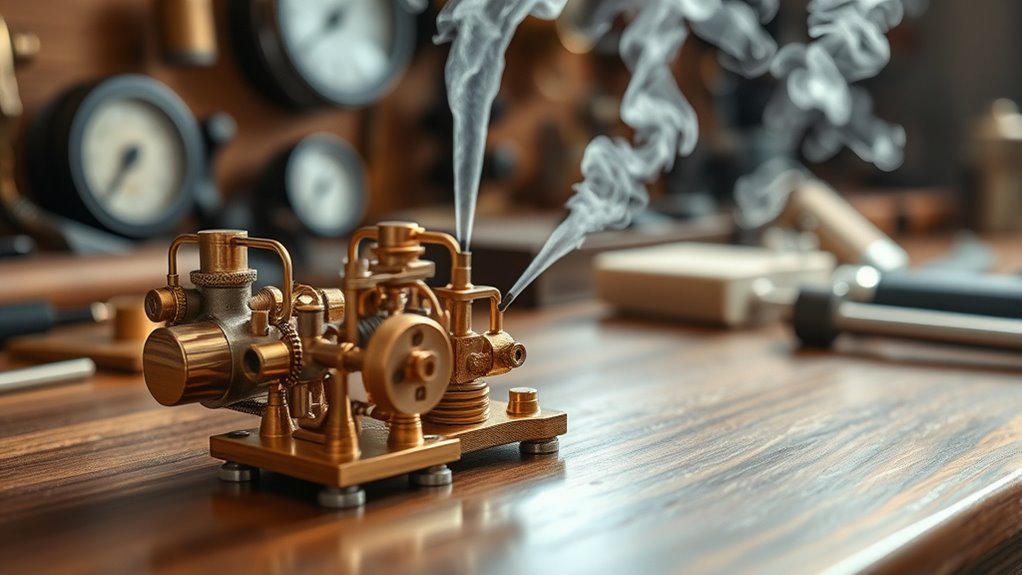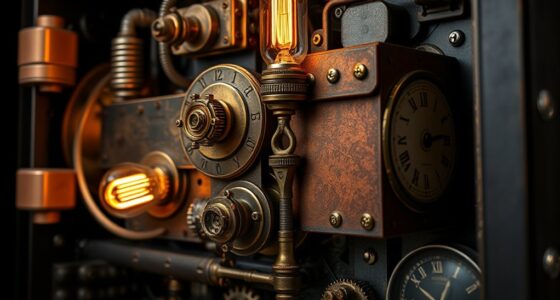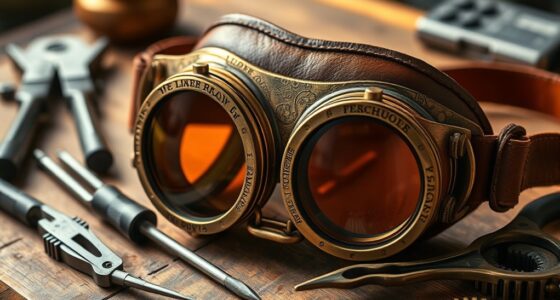Experimenting with tiny steam engines at home lets you connect to a long tradition of innovation, showing how steam power revolutionized industry centuries ago. You’ll gain hands-on understanding of thermodynamics and mechanics, while honing skills in craftsmanship and design. Building miniature engines encourages patience and problem-solving, blending science and art in a satisfying hobby. As you explore further, you’ll discover how these models celebrate engineering history and inspire personal creativity—there’s much more to uncover.
Key Takeaways
- Building miniature steam engines offers hands-on learning of thermodynamics and mechanical principles at home.
- Crafting tiny steam models involves selecting precise materials and practicing detailed assembly skills.
- Experimenting with small steam engines celebrates engineering history while fostering patience and problem-solving.
- These projects serve as educational tools, deepening understanding of steam power’s role in industrial development.
- Creating and testing miniature steam engines provides a rewarding blend of science, craftsmanship, and personal creativity.

Tiny steam engines might seem like small wonders, but they pack impressive power and ingenuity. These miniature marvels connect you to a long-standing tradition rooted in steam engine history, showcasing how inventive minds harnessed steam to revolutionize transportation and industry centuries ago. Today, building tiny steam engines allows you to explore this fascinating history firsthand while honing your skills in miniature model building. It’s a rewarding hobby that combines engineering, craftsmanship, and a touch of nostalgia, all within the comfort of your home.
When you start experimenting with miniature steam power, you step into a world where precision and patience pay off. Creating small steam engines involves understanding basic principles of thermodynamics and mechanics, which isn’t just educational—it’s empowering. You learn how heat transforms into motion, how pressure drives pistons, and how clever design makes these tiny engines run smoothly. As you assemble each component, you get to appreciate the ingenuity behind early industrial advances and see how those concepts translate into miniature form. This process deepens your appreciation for the history of steam engines, which initially powered locomotives, ships, and factories, transforming societies and economies.
Building miniature steam engines isn’t just about following instructions; it’s about engaging with a craft that demands attention to detail. You select materials like brass, copper, and steel, and craft tiny cylinders, pistons, and boilers with precision. Many hobbyists find joy in designing their own models, customizing parts, and experimenting with different configurations. This hands-on approach allows you to see immediate results, fueling your curiosity and encouraging iterative improvements. Whether you’re replicating historical engines or inventing your own designs, the process keeps you connected to the roots of steam power while pushing your technical skills.
As you progress, you realize that miniature model building isn’t just a pastime—it’s a form of storytelling. Your small steam engine becomes a symbol of innovation and perseverance. You might even display it as a collector’s piece or demonstrate it to friends, sharing the wonder of steam’s power in a compact form. Over time, you’ll find that working on tiny steam engines helps you develop patience, problem-solving skills, and a greater appreciation for engineering history. It’s a hobby that’s as educational as it is satisfying, blending the past with your present creativity.
Ultimately, experimenting with tiny steam engines at home offers a unique way to connect with history, challenge your skills, and enjoy the simple pleasure of seeing steam-powered motion in miniature. It’s a perfect blend of science, art, and nostalgia—making every successful run a small but mighty triumph. Incorporating quality assurance practices can help ensure your builds are reliable and enjoyable, supporting your ongoing learning and craftsmanship.
Frequently Asked Questions
What Safety Precautions Are Necessary When Building Tiny Steam Engines?
When building tiny steam engines, you need to prioritize safety, especially around steam pressure and boiler safety. Always wear safety gear like gloves and goggles, and work in a well-ventilated area. Regularly check your boiler for leaks, corrosion, or damage, and never over-pressurize it. Use a pressure relief valve, and monitor steam pressure closely to prevent accidents. Proper safety precautions keep your experiments safe and enjoyable.
How Do I Troubleshoot Common Issues With Miniature Steam Engines?
When troubleshooting your miniature steam engine, start by checking lubrication techniques to guarantee all moving parts are well-oiled, reducing friction and wear. Then, focus on steam pressure control; if the engine stalls or runs unevenly, adjust the pressure valve gradually. Inspect for leaks or blockages, and clean components regularly. These steps will help keep your engine running smoothly and efficiently, preventing common issues from disrupting your experiments.
What Are the Best Materials for Constructing Tiny Steam Engine Parts?
You’d think tiny steam engine parts could be made from anything, but ironically, material selection is essential. For durability assessment, opt for brass or stainless steel—they resist corrosion and handle heat well. Avoid cheaper plastics that warp or break easily. Your goal is precision and longevity, so prioritize materials that withstand pressure and wear. With careful choice, your miniature engine will run smoothly and endure many experiments to come.
Can I Power Tiny Steam Engines With Alternative Fuels?
You can power tiny steam engines with alternative fuel sources, and eco-friendly combustion options are a great choice. Using materials like bioethanol, biodiesel, or other renewable fuels reduces environmental impact and offers cleaner operation. Just guarantee your engine is compatible with these fuels and that you manage the combustion process safely. Experimenting with alternative fuels not only enhances sustainability but also provides a fun way to explore eco-conscious steam power.
How Do I Measure the Efficiency of My Miniature Steam Engine?
Imagine your engine is a finely tuned orchestra; measuring its performance reveals the harmony. To assess steam efficiency, you should use measurement techniques like tracking fuel input versus work output, noting temperature and pressure changes. Record your findings carefully, calculating the ratio of useful work to energy supplied. This way, you turn your miniature engine into a precise instrument, revealing its true steam efficiency and helping you optimize performance.
Conclusion
You’ve just uncovered a world where tiny steam engines release enormous fun and creativity. With a little patience and curiosity, you can craft miniature powerhouses that rival full-sized machines in excitement. Imagine the thrill of watching these tiny engines chug to life, transforming your home into a bustling workshop of innovation. Don’t underestimate the power of a small engine — it’s like holding a miniature universe of engineering wonder right in your hands!









